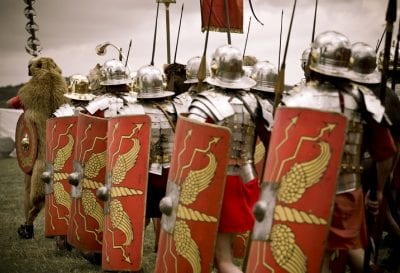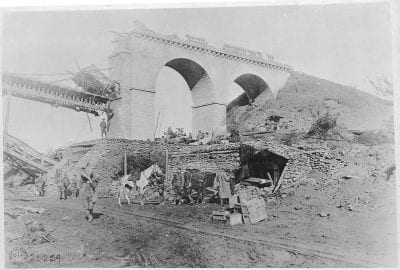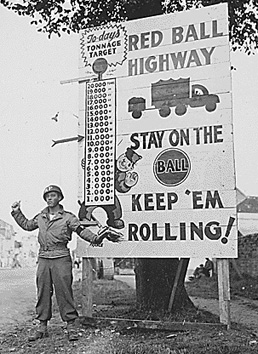“The line between disorder and order lies in logistics.” – Sun Tzu
Logistics and supply are one of the most essential functions for any military, modern or historical. Operational logistics for a military refer to the set of activities carried out in order to satisfy the needs of those involved. This includes food, transportation, war materials, medical services, and much more.
Dawn of War
Since the first recorded war in history took place in Mesopotamia, there has always been a need to supply the troops fighting it. Some of the first kings and generals had two simple choices for supply chain management when they chose to send their army out on a campaign.
The first method was simple, bring what you need however you can. Pack animals, wagons, and ships were the leading means of transport in antiquity. This has one major fault in that bringing supplies on a campaign leads to long lines of ‘baggage’ following the army. Movement is slowed and the supply train becomes a prime target for enemy forces.
Option two was the practice of foraging and looting supplies, primarily fodder. This method was efficient but by no means perfect. No guarantee on supplies could lead to a very unsettled army and too much pilfering could lead to a very unhappy populace in the surrounding countryside. Nothing spurs an armed insurgency better than an occupying army raiding civilian food stores and warehouses.
An Age of Empires
As the size of armies grew and the scope of conflicts greatly increased so did the need for supplies. Alexander the Great’s army of 65,000 men required 195,000 pounds of grain and 325,000 pounds a water every single day. Following in the footsteps of Alexander, the Romans needed to master supply chain management to ease the burden of their massive empire. The Romans saw the importance of supply and created a highly sophisticated logistical system that allowed them to provision large armies at long distances.

The reach and organization of the Roman Legions were unparalleled in the ancient world.
Supply chain management for an army remained relatively unchanged up until the 16th and 17th century when the logistics of overseas campaigns nearly bankrupted the Spanish Empire on several occasions. A new world to explore meant logistics needed to change again. Reforms would highlight the next era of military logistics as armies continued to grow.
Over the Hills and Far Away
The global wars that started to arise in the 17th century posed a multitude of new problems for military logisticians. Supplying a fighting force overseas in a hostile country was a monumental task for the technology at the time. Even after reforming processes the sheer scale of the operations needed was sometimes too much for a nation.
The British faced a horrendous supply situation during the American Revolutionary War. A 3,000-mile journey between ports in Ireland and the colonies was a massive undertaking in its own right. The distance coupled with bad weather, American privateers, and food going bad hampered the British at every turn. Foraging and using the colonies for supplies only further enraged the populace and embroiled the cause that the British were fighting. Ultimately it can be said that supply chain management was a major factor in the British loss.
Major reforms followed the defeat just as the dawn of a new force in military logistics came to power, and his name was Napoleon Bonaparte. Before him, military supply was based on contracts with private companies, looting, and requisition. Logistics became a major internal function of the Grande Armée and was extremely successful during the Ulm campaign in 1805. France’s German allies turned entire towns into supply depots ready for the dedicated supply personal of Bonaparte’s imperial army. Despite early successes at Ulm and Austerlitz, the French mastery of supply and logistics faltered under the British blockade and in the face of guerrilla warfare in the Peninsular War in Spain.

The next major advance came in the form of a new transportation method, railroads. Rail transport greatly expanded an armies mobility and reach. The American Civil war was a hallmark moment for military logistics. Railways were used to great effect, but they became yet another target for guerrillas and raiders. Men, weapons, and supplies could now be moved across vast distances in a very short amount of time compared to traditional methods. The Prussian use of railways during the Franco-Prussian War is often cited as a prime example of logistic modernizations where the Germanic army crushed the French Empire in a very short period of conflict.
Industrialized and Mechanized Warfare
The turn of the century and the beginning of the Great War led to yet another shift in military logistics. Conscription led to absolutely massive armies numbering in the millions and battlefronts that spanned an entire continent. Industrialized firepower such as massed artillery, machine guns, and airplanes led to an increased demand in munitions. Most logistics strategies during the war relied on 19th-century techniques.

The First World War saw the capabilities of rail and horse-drawn supply stretched to their limits. The German Army had an initially successful spring offensive in 1918 devolve into utter failure when the logistics failed to keep up with the army’s advance over the destroyed landscape. The failure of Operation Micahel was the final nail in the coffin for the Central Powers.
The Second World War saw an increase in mechanization with the widespread usage of trucks replacing horse-drawn supply lines. While they require better roadways they are much faster than their animal counterparts. The lack of infrastructure and climate greatly affected the logistics of any troop movements in the North African Campaign, Burma, and elsewhere. Germany’s invasion of the USSR, Operation Barbarossa, lost momentum due to poor logistical planning despite victories on the battlefield.

Air power targeting supply lines, submarines attacking shipping, and the island-hopping campaigns of the Pacific Theater made logistical planning a vital part in the Allied victory in the war on all fronts.
Modern military logistics is now a high tech field with predictive forecasting, operations research, and the most efficient means to get the supplies where they need to be. Technology coupled with a global playing field has made the task even larger than before. Military logistics techniques have become widely deployed in the commercial world and vice-versa.
Conflicts, resources, and technology continue to evolve and so will the need to supply armies in the field. Military logistics is a key component in any fighting force on the planet. As often seen throughout history the victor is typically the one that can keep their troops supplied.


